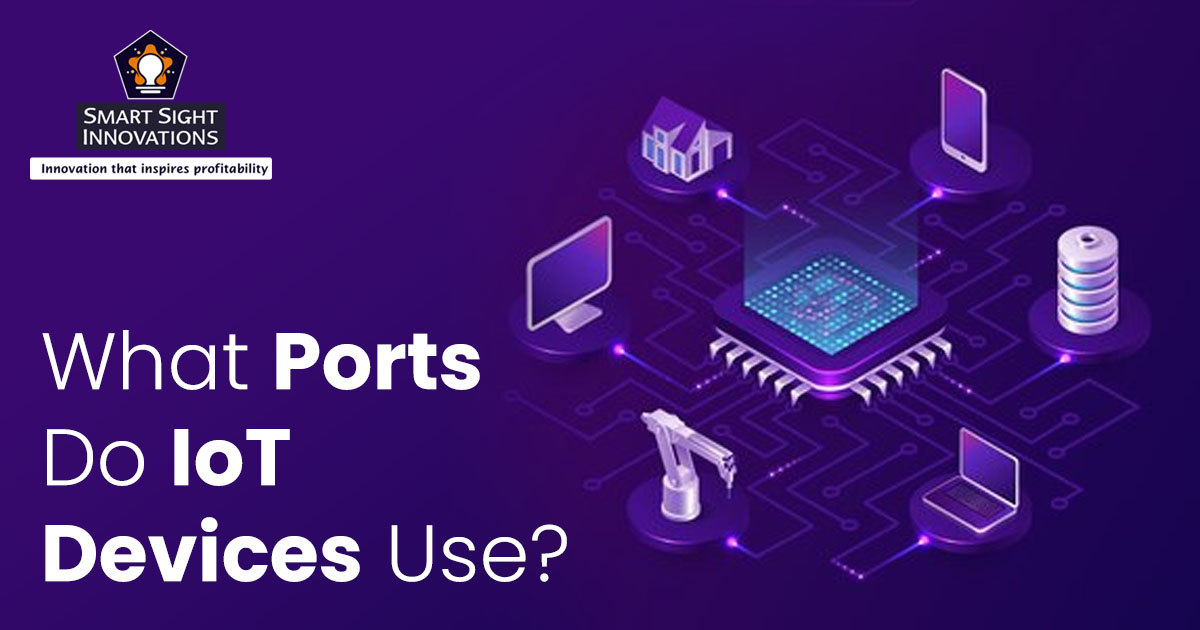
IoT devices are everywhere — from smart thermostats and wearables to industrial sensors and connected appliances, these devices communicate and collect data using various protocols. But have you ever wondered what ports these devices use to function?
This article explains the most commonly used protocols and their designated ports. Learn why you should choose specific ports and how they ensure seamless communication between devices and the broader IoT ecosystem.
Why Do Ports Matter?
Every device on a network communicates through designated channels called ports. These ports act like numbered doorways, allowing specific types of data to flow in and out.
For a secure connection, choosing the right ports and protocols is crucial. Protocols are essentially “languages” that devices use to understand each other.
Just like humans need a common language to communicate effectively, devices rely on protocols to exchange data securely. Many people mistakenly believe all IoT devices use the same ports. This misconception can lead to security vulnerabilities.
Different devices often utilize a variety of ports depending on their functionality and the protocols they employ. Understanding which ports are used by specific devices empowers users to identify potential security risks and take necessary precautions.
Ports and Protocols: The Language of Network Communication
Imagine a bustling city with dedicated lanes for different types of vehicles. Cars navigate designated roads, while bicycles utilize designated bike paths. This organized flow ensures efficient and safe movement.
In the digital world, network communication functions similarly, relying on two key elements: ports and protocols. Understanding these elements unlocks the secrets of how devices exchange information securely within the vast landscape of the internet.
-
Ports
Ports are like numbered doorways on a device where each port acts as a specific channel for incoming and outgoing data. This allows devices to handle different types of communication simultaneously, just like the city with dedicated lanes.
For example, a web browser might use port 80 (HTTP) to access websites, while an email client might use port 25 (SMTP) to send emails. These standardized port numbers ensure devices “speak the same language” and route data efficiently.
-
Protocols
Protocols define a set of rules for data exchange between devices. They dictate how data is formatted, packaged, and transmitted across the network.
Popular protocols for IoT devices include Hypertext Transfer Protocol (HTTP), Hypertext Transfer Protocol Secure (HTTPS), Message Queuing Telemetry Transport (MQTT), and Advanced Message Queuing Protocol (AMQP).
The Interaction of Protocols and Ports
Ports and protocols work hand-in-hand to ensure seamless and secure network communication. When a device initiates communication, it specifies a port number and the corresponding protocol. This information helps the receiving device understand the type of data being sent and how to handle it appropriately.
For instance, when you visit a website using a web browser, your browser sends a request using port 80 (HTTP) to the web server. The server understands this request because it’s expecting HTTP communication on port 80.
Commonly Used Ports in IoT Devices
Different devices and applications utilize specific network ports to facilitate communication and data exchange. The most commonly used ports in IoT devices.
-
Port 80 (HTTP)
HTTP is used for transmitting web pages over the internet. IoT devices often use HTTP for communication, especially in scenarios where real-time data transfer is not critical.
-
Port 443 (HTTPS)
HTTPS is the secure version of HTTP, encrypting data to protect it from eavesdropping and tampering. Many IoT devices use HTTPS for secure communication, ensuring that sensitive data remains protected.
-
Port 1883: MQTT Protocol
MQTT (Message Queuing Telemetry Transport) is a lightweight messaging protocol intended for low-bandwidth networks and devices with limited resources. It operates on port 1883 and is widely used in IoT applications for its efficiency and low power consumption, making it ideal for scenarios requiring frequent updates or real-time data.
-
Port 5683: CoAP Protocol
The CoAP (Constrained Application Protocol) is designed for use in resource-constrained environments. It is similar to HTTP but optimized for low-power devices and lossy networks. CoAP operates on port 5683 and is commonly used in smart home devices, industrial applications, and other IoT scenarios where lightweight and efficient communication is necessary.
-
Port 8883: Secure MQTT (MQTTS)
The secure MQTT uses TLS/SSL to encrypt MQTT messages, providing an additional layer of security. MQTTS typically operates on port 8883 and is used in applications where secure data transmission is critical, such as in financial services, healthcare, and other sensitive industries.
-
Port 8000-9000: Custom IoT Protocols
Many IoT devices and platforms use custom protocols that operate within this range of ports. These custom protocols are designed to meet specific requirements of various applications, offering flexibility in communication while addressing unique constraints of different IoT environments.
Categorizing the Ports Based on Functionality
Understanding the ports used by your IoT devices is a crucial step in ensuring their security. Let’s categorize the ports based on their functionality:
-
Smart Home Devices
These devices transform your living space into a connected haven. Examples include smart thermostats (Nest Learning Thermostat – Port 8080), smart lights (Philips Hue – Port 6850), and smart speakers (Amazon Echo – Port 443).
-
Wearables
These devices keep you connected and monitor your well-being. Examples include fitness trackers (Fitbit Charge 5 – Port 443) and smartwatches (Apple Watch – Port 443).
-
Industrial IoT Devices
These devices play a vital role in industrial automation and monitoring. Examples include smart sensors (various depending on manufacturer – typically range from Port 5000 to Port 65535) and industrial controllers (Siemens Simatic S7 – Port 102).
Security Considerations for IoT Ports
Ensuring the security of network ports used by IoT devices is crucial for protecting against cyber threats and maintaining the integrity of the IoT ecosystem. Since IoT devices often handle sensitive data and are integrated into critical systems, securing these communication endpoints is a top priority. We look at potential risks associated with open ports, best practices for securing IoT ports, and common security protocols.
-
Potential Risks of Open Ports
Open ports on IoT devices can expose networks to various security threats, including:
1. Unauthorized Access
Open ports can be entry points for unauthorized users or malicious actors attempting to gain access to the network.
2. Data Interception
Unsecured ports may allow attackers to intercept and manipulate data being transmitted between IoT devices and servers.
3. DDoS Attacks
Open ports can be exploited to launch Distributed Denial of Service (DDoS) attacks, overwhelming IoT devices and networks with traffic and causing disruptions.
4. Malware Injections
Vulnerable ports can be used to inject malware into IoT devices, compromising their functionality and potentially spreading to other networked devices.
-
Best Practices for Securing IoT Ports
Implementing robust security measures is essential to mitigate the risks associated with open ports. Here are some best practices for securing IoT ports:
1. Port Management
Regularly review and manage the ports used by IoT devices. Close any unused or unnecessary ports to minimize the attack surface.
2. Firewalls
Firewalls help monitor and manage both inbound and outbound network traffic. Configure firewall rules to allow only necessary ports and block all others.
3. Network Segmentation
Divide your network into segments to keep IoT devices apart from other important systems. This limits the potential impact of a compromised device on the broader network.
4. Access Control
Implement strong access control mechanisms, including authentication and authorization, to ensure that only authorized users and devices can access IoT ports.
5. Encryption
Use encryption protocols to secure data transmitted over open ports. Encrypting data ensures that even if intercepted, it cannot be read or tampered with.
-
Common Security Protocols
Common security protocols can be employed to enhance the security of IoT ports:
1. TLS/SSL (Transport Layer Security / Secure Sockets Layer)
By encrypting data, these protocols offer safe network connection. They are widely used for securing HTTP (HTTPS) and MQTT (MQTTS) communications.
2. DTLS (Datagram Transport Layer Security)
DTLS is based on TLS but designed for datagram-based applications like CoAP. It provides similar security benefits, ensuring data integrity and confidentiality.
3. VPNs (Virtual Private Networks)
VPNs create a secure, encrypted connection over a less secure network. Using a VPN can help protect data transmitted between IoT devices and servers.
Securing the ports used by IoT devices is a critical aspect of maintaining a robust and secure IoT environment. By understanding the potential risks associated with open ports and implementing best practices and security protocols, you can protect your IoT devices from cyber threats and ensure reliable and secure communication within your network. In the next section, we will discuss port management strategies and tools to help you effectively monitor and control IoT ports.
Port Management in IoT Networks
Effective port management is crucial for maintaining the security, performance, and reliability of IoT networks. Properly managing the ports used by IoT devices ensures that data flows smoothly, unauthorized access is prevented, and potential security threats are mitigated.
1. Configuring Ports on IoT Devices
- Determine which ports are essential for the operation of your IoT devices. Each device and application will have specific port requirements based on the protocols they use.
- While many IoT devices come pre-configured to use standard ports, consider using custom ports to obscure common entry points and reduce the risk of automated attacks.
- Ensure that ports are configured securely by disabling unused ports and services. Use strong authentication methods to control access to critical ports.
2. Network Traffic Monitoring
- Implement real-time monitoring tools to track network traffic and identify any unusual or suspicious activity. Tools like Wireshark, Nagios, and SolarWinds can help monitor traffic patterns and detect anomalies.
- Regularly analyze traffic data to identify trends and potential security threats. Look for patterns such as unexpected spikes in traffic, repeated access attempts to specific ports, or communication with unknown IP addresses.
- Set up alerts and notifications for abnormal traffic behavior. This allows for prompt investigation and response to potential security incidents.
3. Using Firewalls and Network Address Translation (NAT) for IoT Security
- Configure firewall rules to allow only necessary traffic while blocking unauthorized access. Firewalls can be hardware-based (e.g., network appliances) or software-based (e.g., host-based firewalls on IoT devices).
- Ingress Filtering
Control incoming traffic by specifying which ports and IP addresses are allowed to communicate with your IoT devices.
- Egress Filtering
Control outgoing traffic to prevent IoT devices from communicating with unauthorized or suspicious destinations.
- NAT enhances security by masking the internal IP addresses of IoT devices, making it harder for attackers to directly target individual devices.
- Use NAT to forward specific ports from your external IP address to internal IoT devices. This ensures that only designated traffic reaches the appropriate device.
- Implement dynamic NAT to assign temporary public IP addresses to IoT devices when they initiate outbound connections, providing an additional layer of security and privacy.











